The Mercedes-AMG GT3 LM is one of the most recent additions to the LMGT3 grid in Le Mans Ultimate. With its naturally aspirated 6.3-liter V8 and front-engine layout, it combines stability, endurance, and a strong character behind the wheel. But beyond the raw pleasure of driving it, this car illustrates how modern simulation is no longer just about “playing”—it’s about analyzing.

Every brake application, every ABS activation, every hint of slip is calculated by the physics engine. But to transform that signal into exploitable knowledge, one needs mechanical consistency that goes beyond human precision. And this is where the P1 SIM Mistral pedals become central. Their precision and lap-after-lap repeatability allow the transition from subjective feel to measurable data, from vague impressions to applied engineering in sim racing.
The P1 SIM Mistral: consistency and fidelity in GT3 braking
Consistency as the foundation of analysis
Braking in GT3 is a science of its own. Unlike prototypes, which rely heavily on aerodynamic downforce, a GT3 requires mastering mechanical grip, ABS intervention, and precise driver modulation. Three phases follow: loading the front axle, stabilizing deceleration, and progressively releasing pressure to initiate rotation.

The use of SOFT + Very Hard elastomers replicates reality: a progressive pedal at the beginning, firm and demanding at the end. This is what allows modulation of ABS just like in a real GT3.
If the pedals cannot reproduce these phases consistently, telemetry becomes unreadable. Parasite variations blur the real signals. The P1 SIM Mistral solves this problem: robust mechanics, coherent response, and repeatability that make it possible to compare a braking event on lap 1 and lap 20 without the pedal itself being a source of distortion.
Technical calibration and brake curve
The GT3 reference is clear:
F max = 63 kgf≈ 618 N≈ 112 bar
with a 17.8 mm master cylinder and a 5:1 pedal ratio.

This serves as the base for a 4-point SimHub brake curve, tailored for the Mercedes-AMG GT3 LM:
13% (≈ 8 kgf) → initiation phase, weight transfer.
40% (≈ 25 kgf) → heavy deceleration, preserved bite.
71% (≈ 45 kgf) → maximum control zone, fine modulation.
92% (≈ 58 kgf) → near hard stop, ABS threshold.
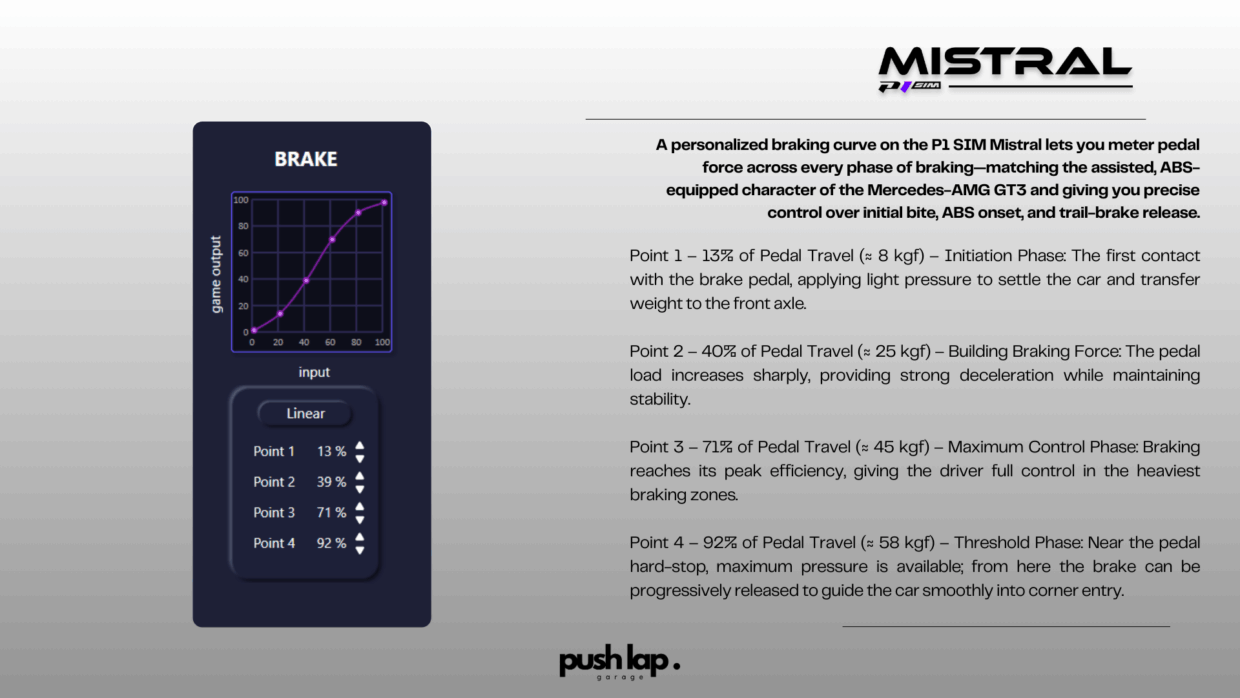
From feel to data: telemetry as a revealer
Concrete example: driver position
With the P1 SIM Mistral, every setup variation becomes visible. Example: comparing driver position -05/00 vs 00/00.
-05/00 → stable FL pressures (167–170 kPa), uniform I/M/O temperatures, reduced wear.
00/00 → pressures dropping toward 165 kPa, hotter inner shoulder, increased wear.
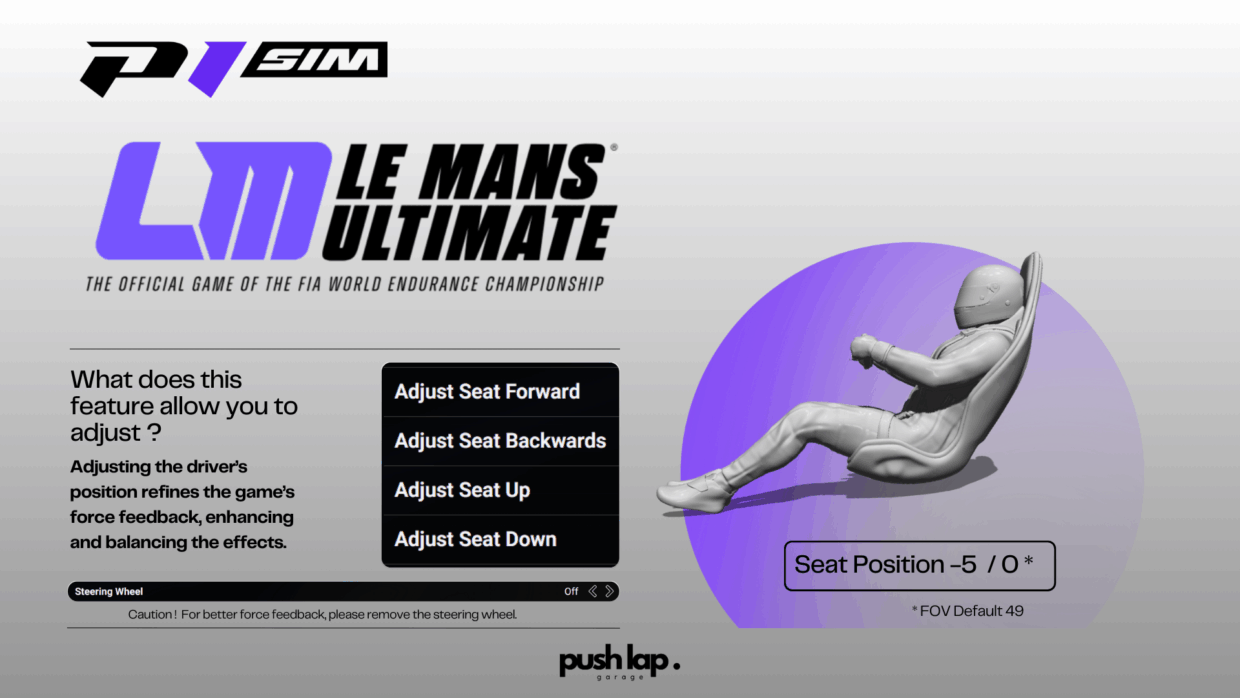
These differences are not perceivable to the naked eye without consistency. With the Mistral, they emerge clearly in the data. The pedal transforms vague impressions into measurable facts.
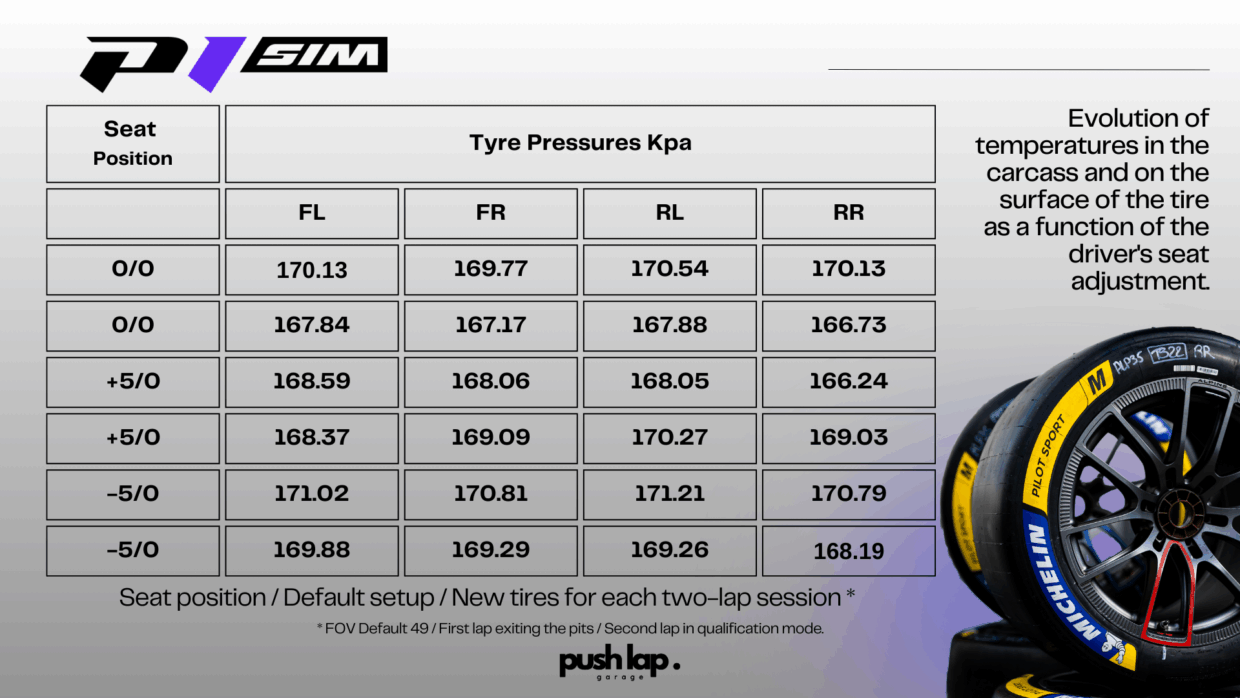
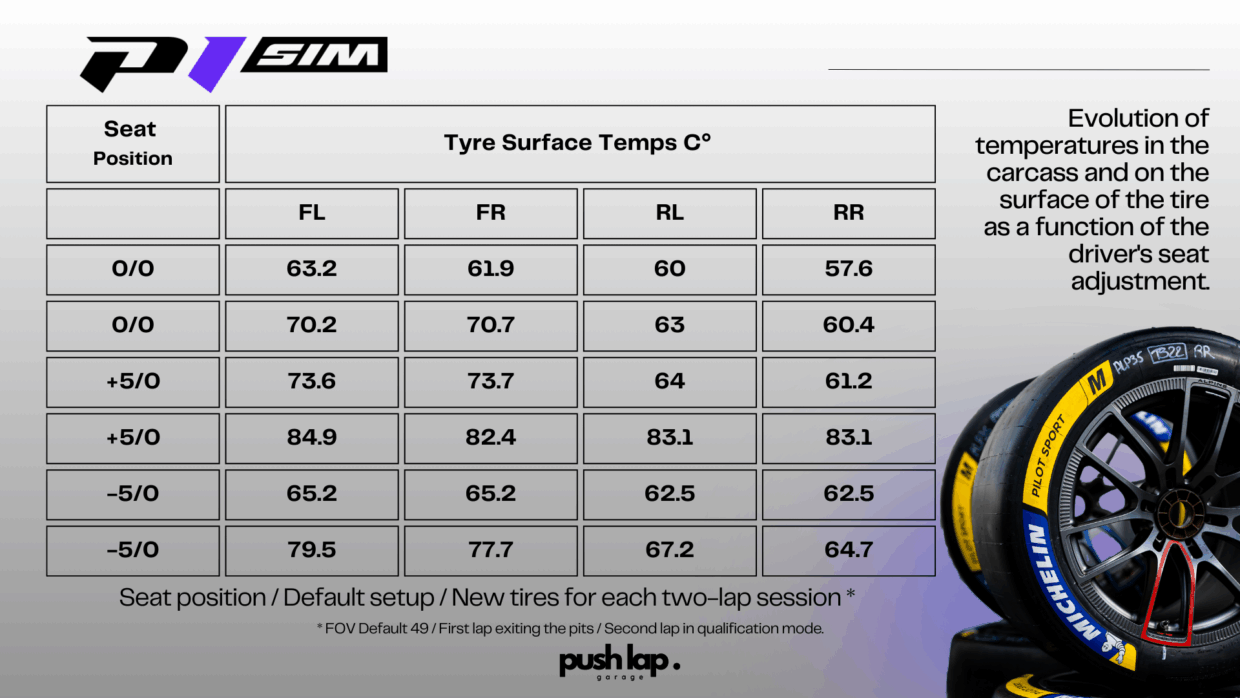
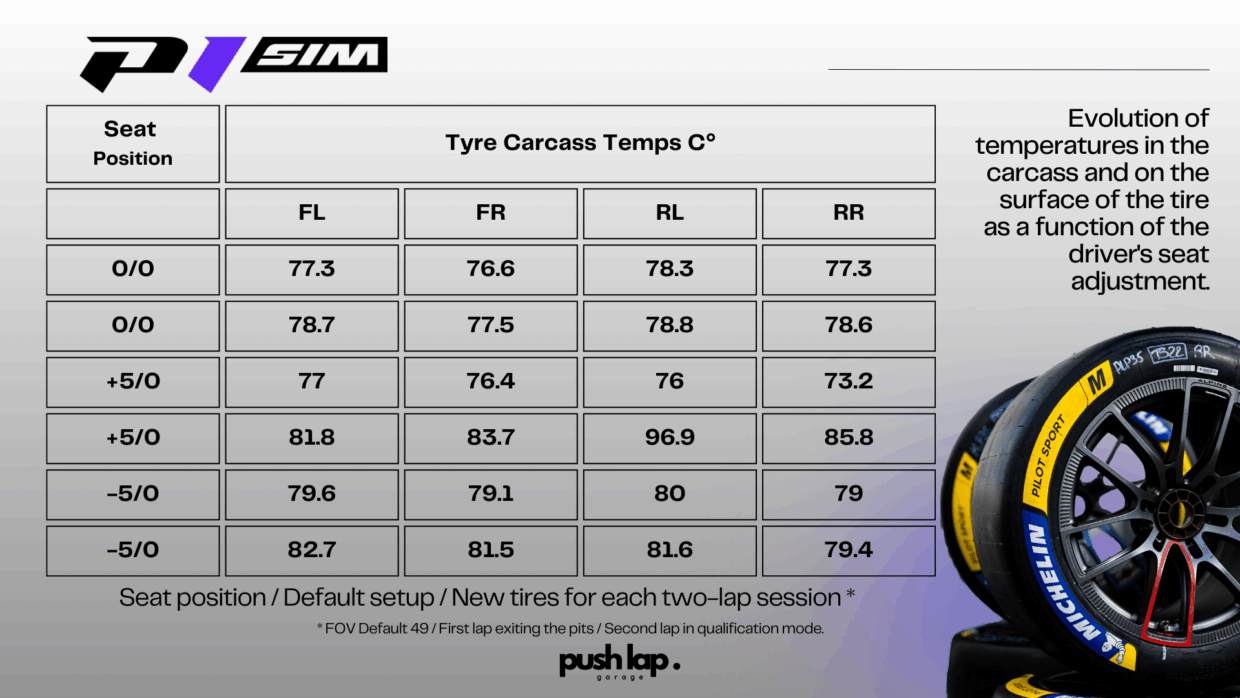

Reading ABS and TC through consistency
The AMG GT3 LM’s ABS is adjustable from 0 to 9. To see the difference between ABS 5 (balanced) and ABS 7 (maximum stability), one must consistently brake just below the ABS threshold. This requires surgical precision, reproducible every lap. The Mistral makes it possible to stay in this critical zone and compare scientifically.
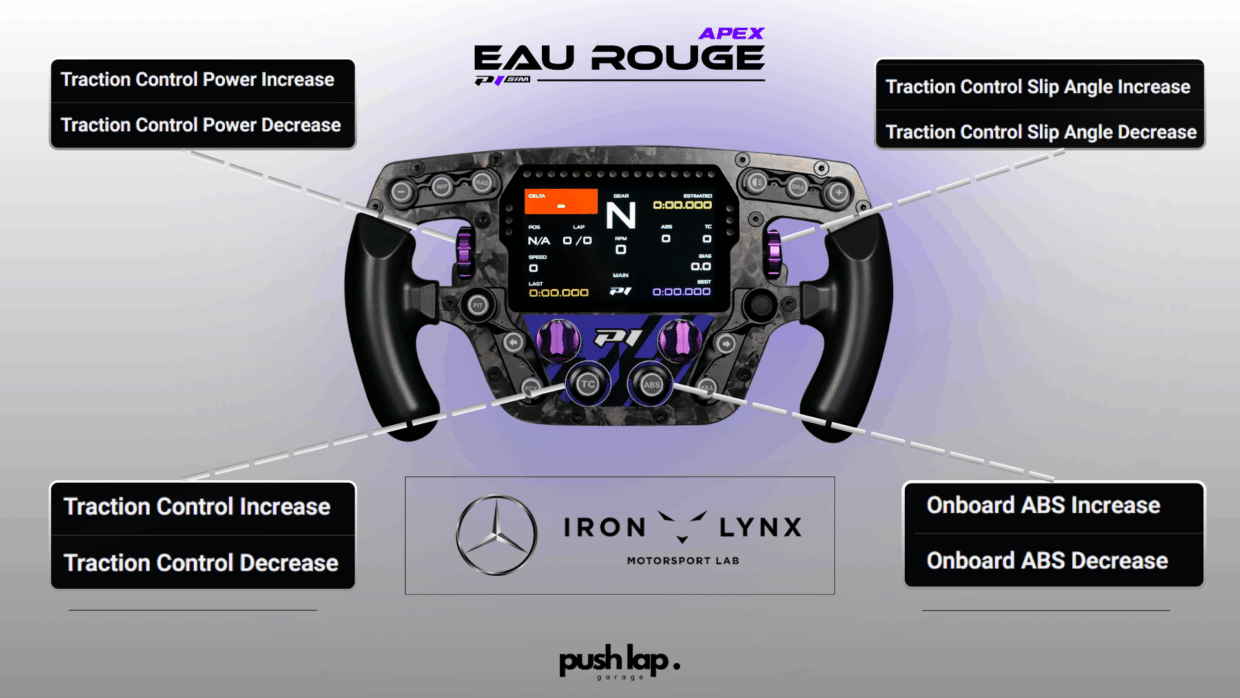
The same logic applies to Traction Control, split into three levers:
TC = when to intervene,
Power Cut = how much to cut,
Slip Angle = how much slip to tolerate.
Without consistency, it’s impossible to distinguish the effect of each lever. With the Mistral, telemetry and lap times immediately reveal the differences.
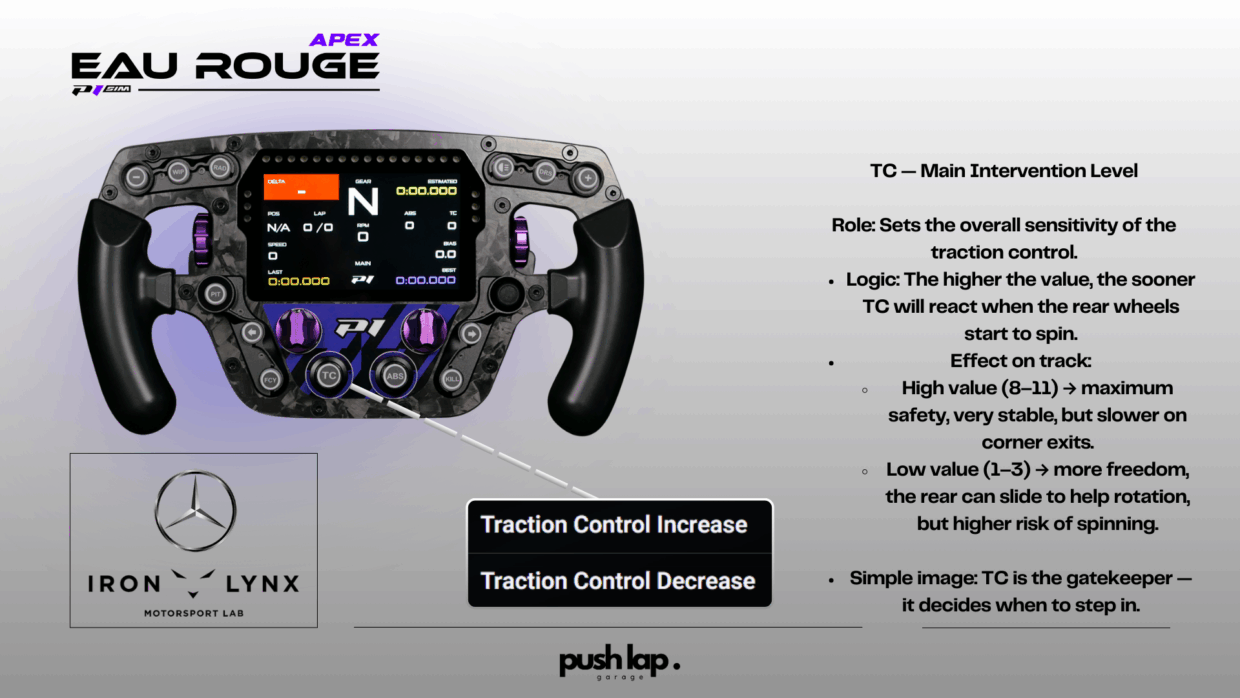

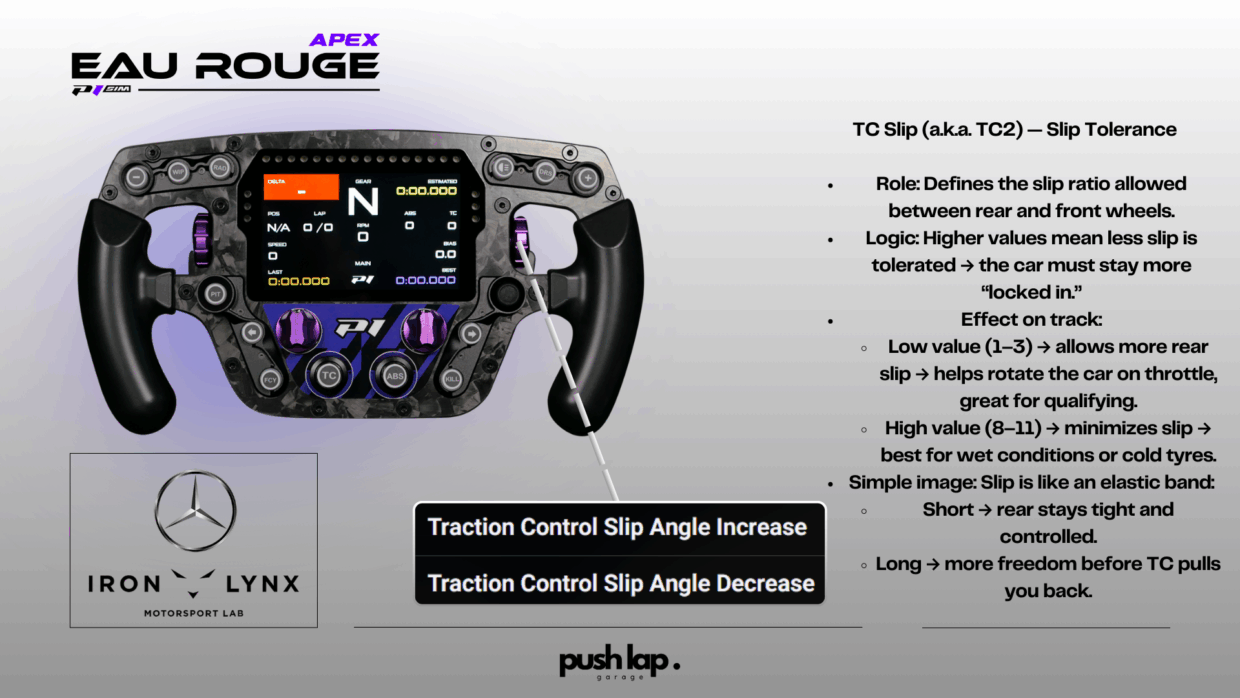
Force Feedback: from p99 to a realistic experience
The role of p99 in FFB calibration
The p99 is the tool that transforms FFB calibration into exact science. Statistically, p99 is the 99th percentile: the value that 99% of samples do not exceed. In FFB terms, it’s the torque generated by the physics engine of the game.
For the Mercedes-AMG GT3 LM, the measured p99 is about 24.4 Nm (24.1–25.3 observed). This means that in 99% of cases, LMU’s physics engine does not output more than 24.4 Nm. The idea is then to map this p99 to about 95% of the wheelbase’s maximum torque.
With this setting, the wheel delivers ~11.4 Nm real-world torque, the load expected in a GT3, without clipping.
The value of p99 is universal: an 8 Nm base would target ~31% gain, a 25 Nm base ~97%. Everyone gets a consistent experience tailored to their hardware, faithful to the physics.
Without p99, two common pitfalls occur:
Too low gain → “soft” wheel, loss of detail.
Too high gain → clipping, saturation, destroyed linearity.
With p99, calibration becomes reproducible, comparable between drivers, and scientifically faithful to the simulation.
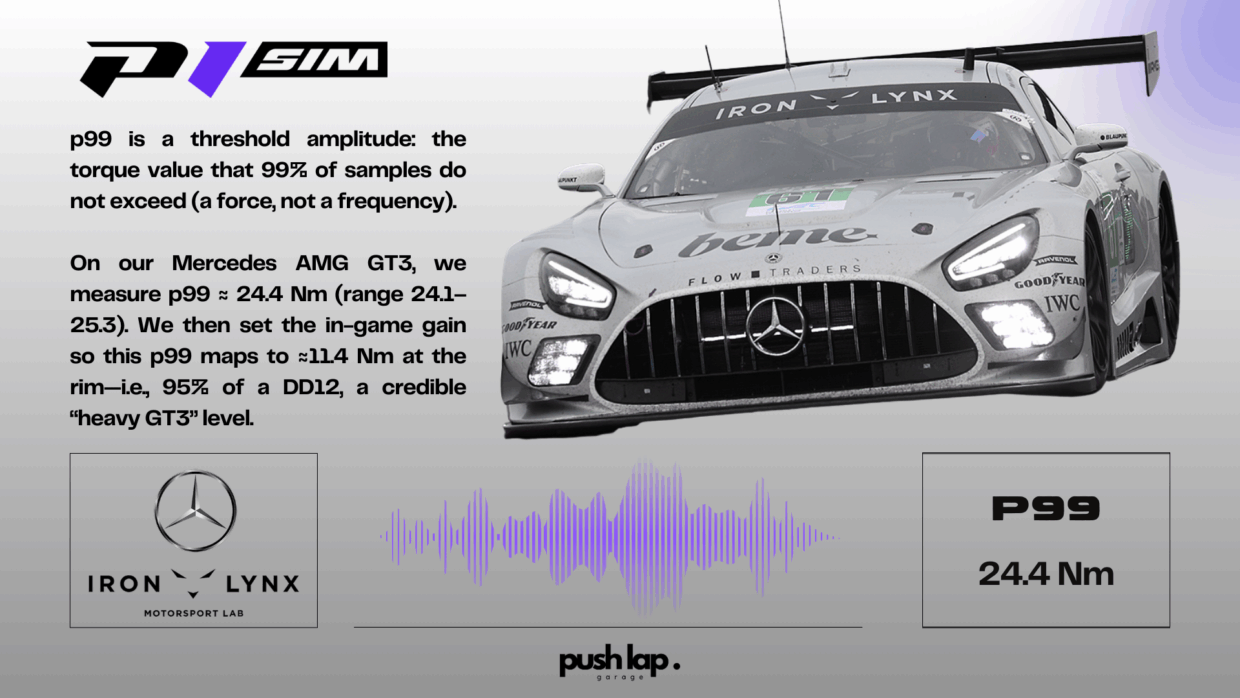
Game/base alignment and synergy with braking
Two scenarios tested:
100% FOR + 55% base FFB → maximum amplitude, but fine signals compressed.
60% FOR + 64% base + 64% in-game → reduced peak torque (7.2 Nm), but perfectly exploited dynamic range.
The conclusion is clear: the second setup makes FFB more “talkative”. And this finding is only readable with a consistent pedal, because only a stable braking baseline allows the FFB effects to be interpreted properly.
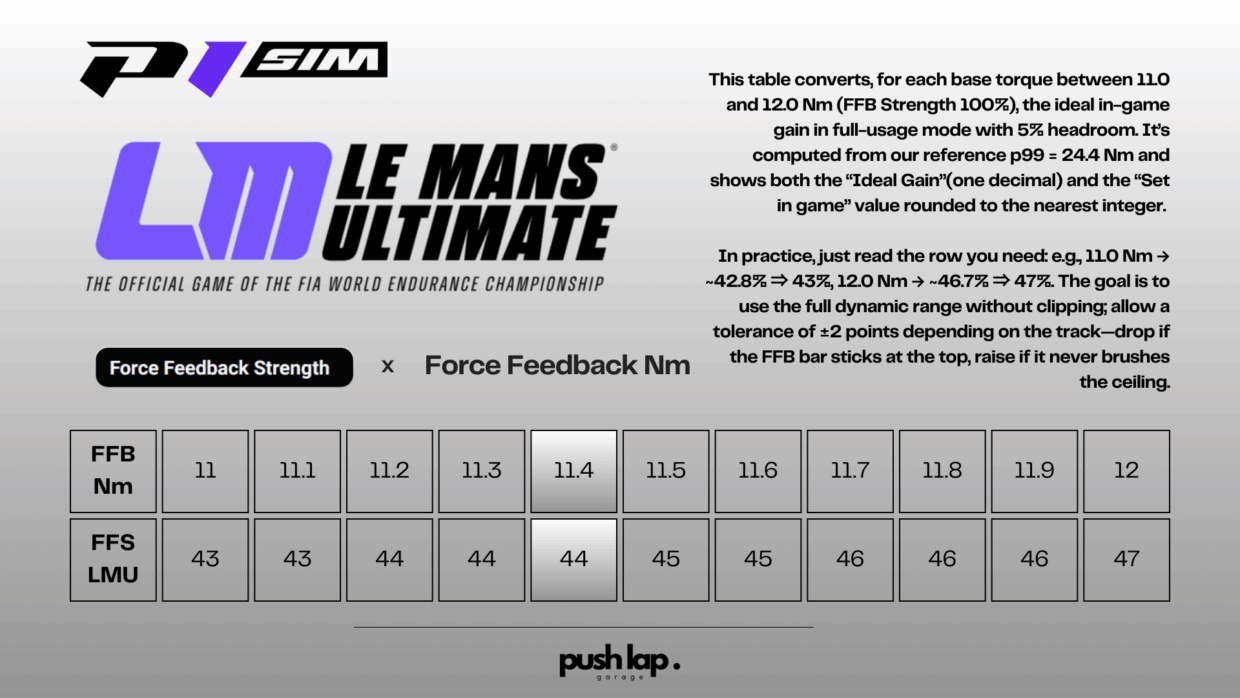
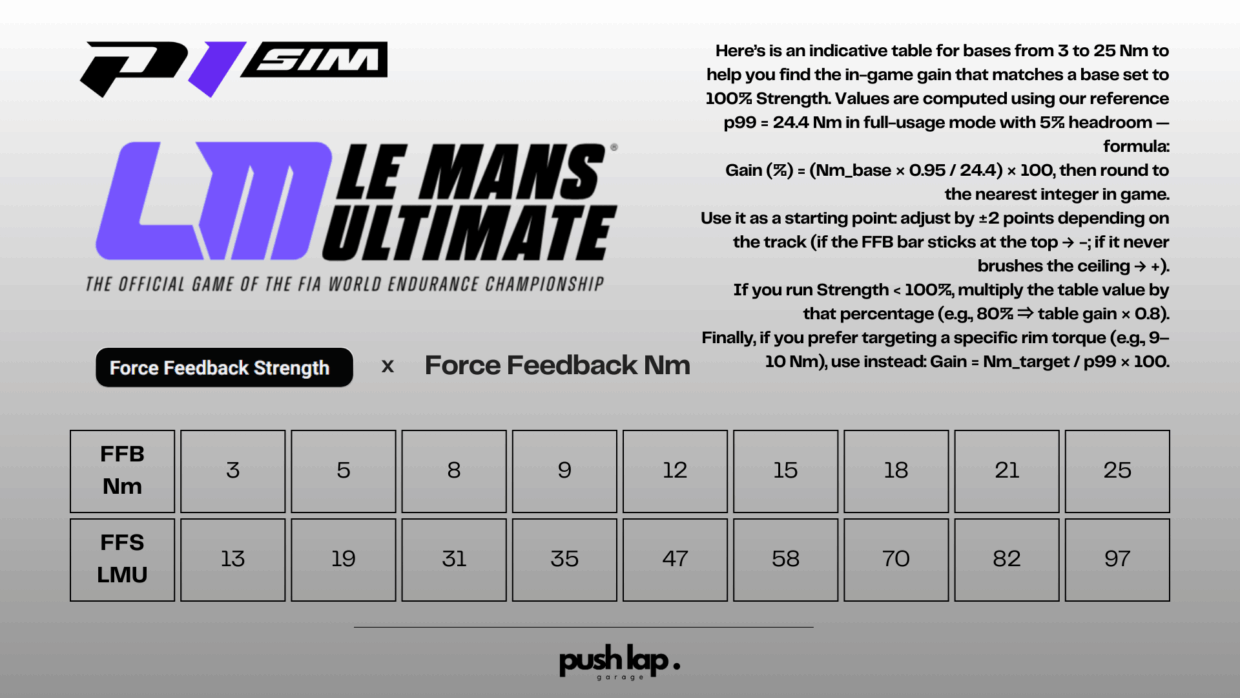
Rotation: 540° to unlock the physics
The Mercedes-AMG GT3 LM is designed for a 540° rotation range.
At 1080°, every physical degree is compressed by two → steering feels soft, center dead zone, muted FFB. At 540°, the mapping becomes 1:1 → precise direction, faithful self-aligning torque, natural corrections.
The difference shows up most in fast direction changes and micro-corrections. Once again, it is the pedal’s consistency that makes this effect measurable: with stable braking, subtle steering differences become visible.
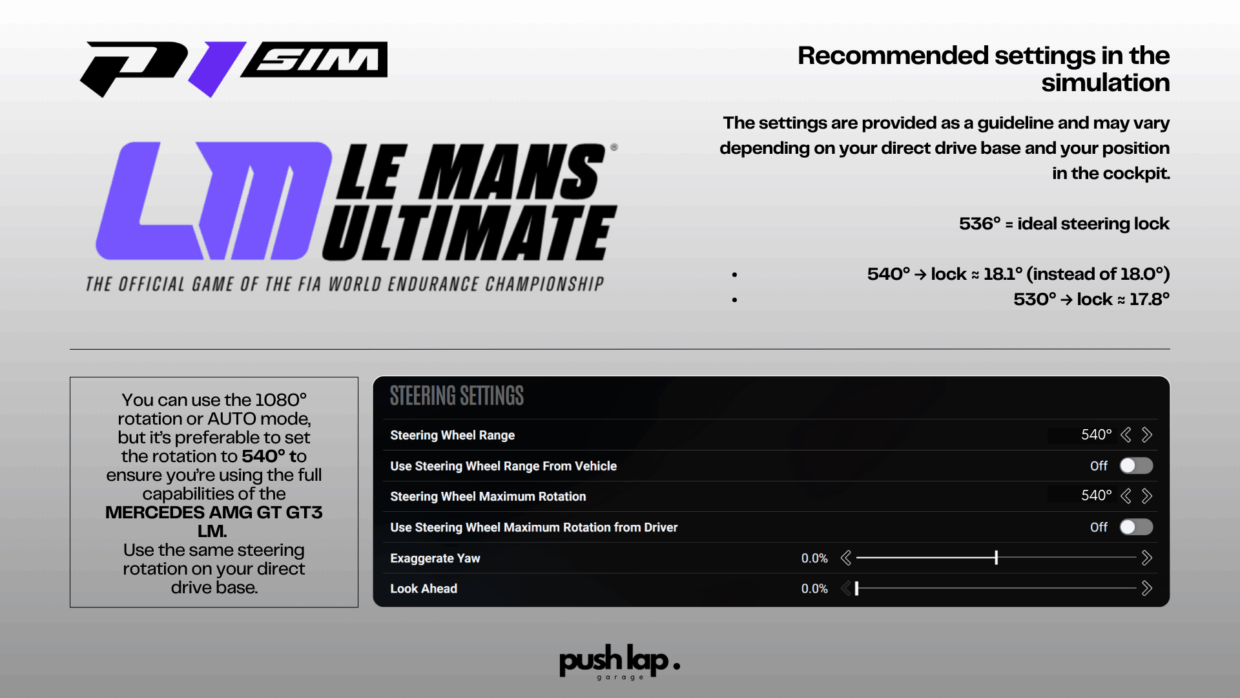
Conclusion: from hardware to knowledge
The Mercedes-AMG GT3 LM in LMU proves one thing: without consistency, no analysis is reliable. The P1 SIM Mistral pedals deliver this consistency and turn driving into a scientific process.
They faithfully reproduce GT3 braking (63 kgf, 112 bar, 4-point curve).
They make telemetry readable, just like in engineering.
They make ABS, TC, FFB, and rotation settings intelligible.
They enable universal, reproducible, and shareable comparisons.
Every Push Lap Garage article is another step forward in exploring sim racing detail. The P1 SIM Mistral is the central tool in this journey, making it possible to transform subjective driving impressions into objective knowledge—and share it with the community for everyone to progress in Le Mans Ultimate.
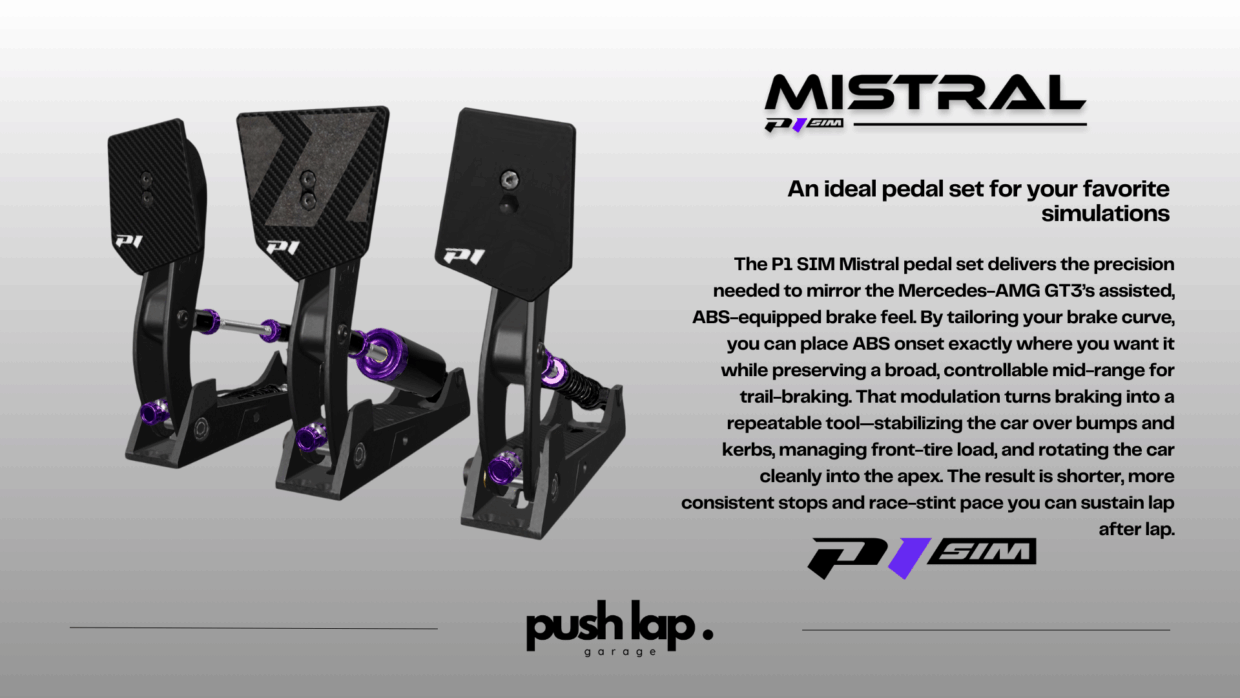

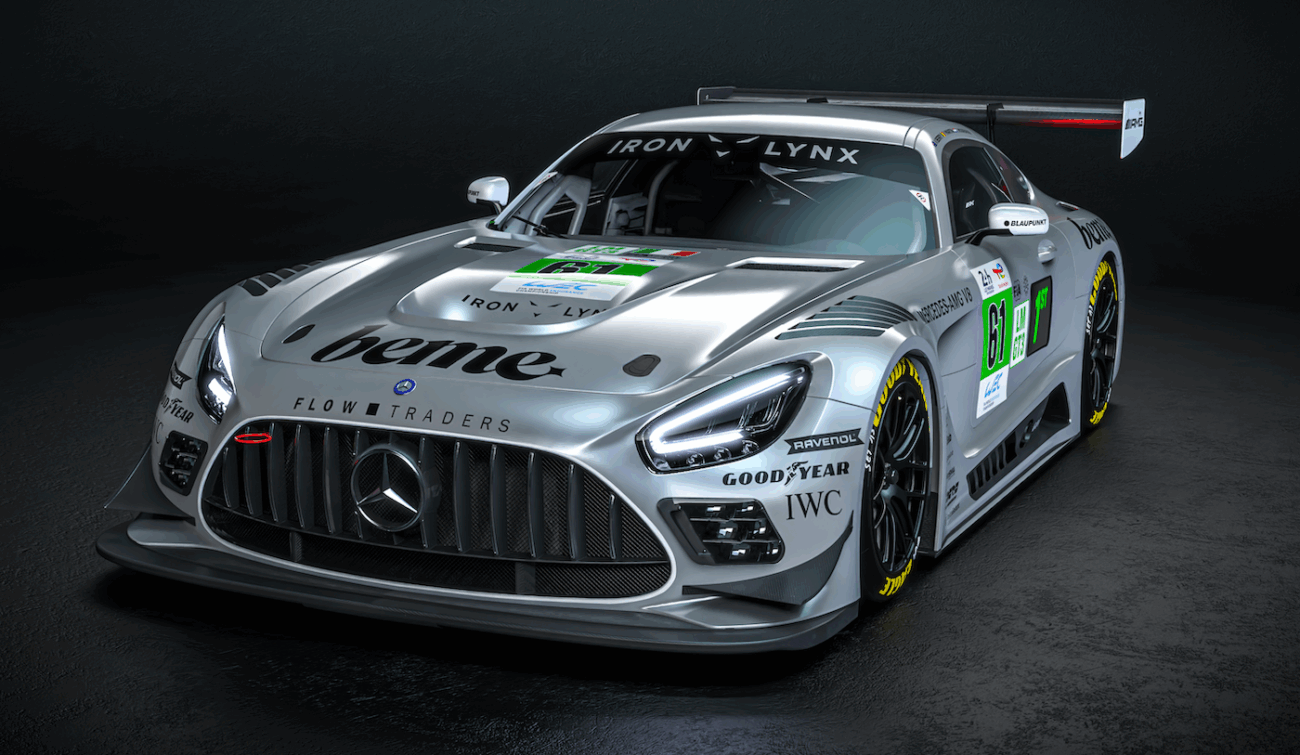
Leave a Comment